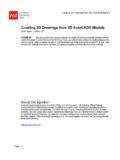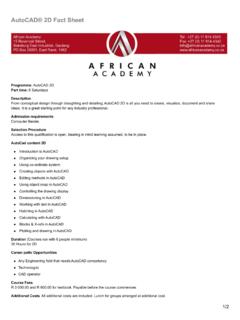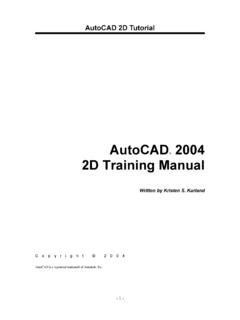Transcription of Create a Reusable Drawing Template Including …
1 Donald B. Cheke TurboCAD Pro Drawing Template Create a Reusable Drawing Template Including Title Block Donald B. Cheke 1. Donald B. Cheke Copyright 2010 Donald B. Cheke TurboCAD is a registered trademark of IMSI/Design. Published by: Donald B. Cheke Saskatoon, SK Canada Visit: All rights reserved No part of this document may be reproduced, copied, stored on a retrieval system or transmitted in any form without written permission from the author. The purchaser may, however, print one copy of the document to paper and may make one backup copy of the downloaded material for personal safe keeping. Limitation of Liability While every effort has been taken in the preparation and the writing of this document the author assumes no responsibility for errors and/or omissions nor for the uses of the material and the decisions based on such use. No warranties are made, express or implied with regard to either the contents of the document, its merchant ability or fitness for a particular purpose.
2 The author should not be liable for direct, indirect, special, incidental or consequential damages arising out of the use or inability to use the contents of this document. Special Note All of the work presented within this tutorial is based on TurboCAD Pro Although users of previous versions are welcome to try the tutorial it cannot be stated what results will be achieved. Many changes, some subtle and others not so subtle, are made with each program revision. Although many steps and directions would be generic some may not be. The same can be said for tools between versions. Older versions may not have the same tools as Pro and if the same tools are available the tools themselves may have been revised and hence, work in a different manner than they previously did. 2. Donald B. Cheke Table of Contents Table of Contents .. 3. Introduction .. 4. 5. Additional Setup and Template Save ..20. Paper Space Title Block ..33. 3. Donald B.
3 Cheke Introduction One of the fundamental tenHts of any CAD package is to never draw the same thing twice. This is very sound advice and a user would be wise to broaden this tenHt to its fullest definition. This not only includes using blocks and symbols while Drawing but it includes devising ways to approach the more mundane things such as repeating text and establishing tool properties or styles. One way to address much of this is to Create a Drawing Template where many properties have been pre-established and which includes at least one paper space page that has a Reusable title block. Within the tutorial the reader will be led through each keystroke to produce a Reusable TurboCAD. Template and the title block that is illustrated on the cover of the tutorial. The reader will find much discussion within the pages of this tutorial that will hopefully provide good insight into choices that are made. This tutorial is in no way intended to teach drafting standards but rather it is intended to teach the use of some of the tools that TurboCAD has to offer and to introduce the new user to a Drawing methodology.
4 The author feels confident that the techniques outlined within the tutorial can help lay the foundation for future successful TurboCAD Drawing and illustration for even the newest user. As with any technically advanced software, the user is generally faced with a steep learning curve. It is the hope of the author that the money and time spent working through a Textual Creations tutorial will help ease the learning and allow the reader to come away feeling confident that they made a wise decision. This tutorial will assume that the reader has the Platinum edition of TurboCAD Pro , although no architectural or mechanical specific tools are used that the author is aware of. There are many ways to approach a project and it is likely that each person using the program would proceed in very different ways, so be open to alternative methods as experience builds. This tutorial assumes that the beginner has studied the desktop to some degree and can locate most of the tools.
5 Since there are endless desktop configurations that can be set up in TurboCAD the author has opted to illustrate the required tools with the Office 2000 user interface and the default toolbars in their undocked format (Office 2000 theme). Please remember that any supplied images and files are for use within the tutorial only and may not be shared or sold to others. Place tutorial images in a permanent location on the hard drive. 4. Donald B. Cheke Additional Setup and Template Save Normally within a Textual Creations tutorial the file that is being worked on would have be saved at the point above with the tutorial name. However, it has been saved with its current name to ensure that a Save has been made before proceeding much further. Other changes will be made now that will become part of the Drawing Template that can be used as the basis for future drawings . After the tutorial a reader can revisit this file and make additional changes that will better suit person needs.
6 Scroll in with the mouse wheel so that the grid is visible on screen. A temporary object will be placed in the Drawing so that it can be zoomed and all users will have the same initial view as part of the Template . Select the Box tool from the 3D Object toolbar. Left mouse click in the Drawing to place the first point of the box. Tab into the Inspector Bar and enter 12. in the Width field, 12 in the Length field and 12 in the Height field. Press Enter. Press the Space Bar to exit the tool. Select the box. Tab into the Inspector Bar and enter 0 in the X, Y and Z Position fields. Press Enter. Select Zoom Extents at the top of the TurboCAD desktop. Press Esc to deselect the selection. This is the point when a user must decide what they want as part of their Template , as there are innumerable things that can be taken into account. Tool settings are Drawing dependant, so they can be changed. Several will be changed now. Select the Double Line tool from the Double Line toolbar.
7 Right mouse click over the Double Line tool icon to open the Properties dialogue for the tool. The tool does not need to be selected to open the Properties dialogue, but sometimes it may need to be selected in order to make the icon available, say from a fly-out menu. 20. Donald B. Cheke Right mouse click over the Text tool on the Text toolbar to open the Properties dialogue for the tool. Under the Text tab, adjust the settings to reflect what is in the image below. Click OK. Remember that colors, layers and so forth can be set as desired under the various tabs while adjustments are made to the tools so that they are set to meet all kinds of drafting standards. Other tools could be gone through in the same manner as above to better suit personal needs, but this will be all for now in the tutorial. Press the Space Bar to exit any tool that may be engaged. Other things such as layers can be created as part of the Template . The author always creates a 2D layer in all drawings to place the various profiles that are used to Create 3D objects, so this will be done now.
8 As errors and changes are unavoidable during the Drawing process, keeping the 2D profiles ensures that everything need not be recreated from scratch when such issues arise. All kinds of preexisting layers can be created, such as Dimensions, Plumbing, Electrical and so forth, but only 2D will be created for the current Template . Open the Design Director palette. Select the New Layer icon at the top off the Design Director palette to Create a new layer. 24. Donald B. Cheke Type 2D in the New Layer name field and click OK or press Enter. Another area where some pre-thought can be of great value is in regards to Styles. Many Styles can be created via the Style Manager and once created they can be easily selected for use in all drawings , as long as they are part of the Template . Two methods will be looked at one will be created from scratch and the other will be created by copying from an existing file that has been supplied. Open the Style Manager palette and expand Text Styles.
9 Select Standard. Disengage Delay Style Modifications and then select the Create New Style icon at the top of the palette. It has been decided that this style will be for a product name. 25. Donald B. Cheke Paper Space Title Block Paper Space can also be set up with a title block, or whatever else is needed. A title block for a Legal Size ( x 14") sheet will be now created. This is a great size for small businesses or hobby users since no special printer is required. Select the Paper 1 tab at the bottom of the Drawing area. Right mouse click on the Paper 1 tab and select Properties from the local menu. Establish the Space Units settings as indicated in the picture below. 33. Donald B. Cheke Select Zoom Full View. Right mouse click on the Paper 1 tab and note that Duplicate can be selected when additional sheets are required during future projects. Press Esc to avoid making any selection at this time. Select the Model tab at the bottom of the TurboCAD desktop.
10 Right mouse click on the Text tool icon to open the Properties dialogue. 59. Donald B. Cheke Select Zoom Extents, if need be. Select and delete the box. Select the Line tool from the Line toolbar. Select Save. From the File menu at the top of the TurboCAD desktop, select Save As. Select TCT TurboCAD Template from the Save as type dropdown menu. Type Imperial in the File name field and then select and copy it as well. Drill to the Template location through the Save in dropdown menu and then select Save. C:\Program Files\IMSID esign\TCWP17\ Template Paste the copied title into the Title field and then click OK. 61.






